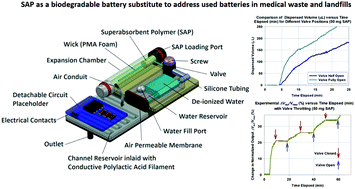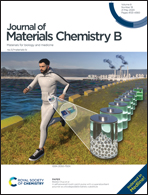A self-powered insulin patch pump with a superabsorbent polymer as a biodegradable battery substitute†
Abstract
Highly popular insulin patch pumps have in-built non-removable batteries. These batteries are routinely disposed of together with the used pumps as medical waste and end up in landfills. This is an environmental contamination conundrum by design. To address this issue, we proposed a self-powered patch pump that uses a biodegradable superabsorbent polymer (SAP) instead of a battery as a power source to drive the infusion. Continuous infusion rates from 6.1 μL min−1 to 49.1 μL min−1 were achieved. Together with valve throttling, basal and bolus infusion rates of ∼10 μL h−1 (1 U h−1) and 100 μL (10 U) in ∼11 min could also be implemented for glycemic control. The generated pressure at ∼0.7 psi is also adequate for infusion as it exceeded an adult's maximum peripheral venous pressure of 0.6 psi. Given the current number of patch pump users, the proposed design could prevent ∼100 000 used batteries from entering the medical waste stream and landfill daily. Most importantly, this work highlights the possibility of addressing environmental contamination without compromising on healthcare standards by using SAP as an alternative means of energy storage.



 Please wait while we load your content...
Please wait while we load your content...